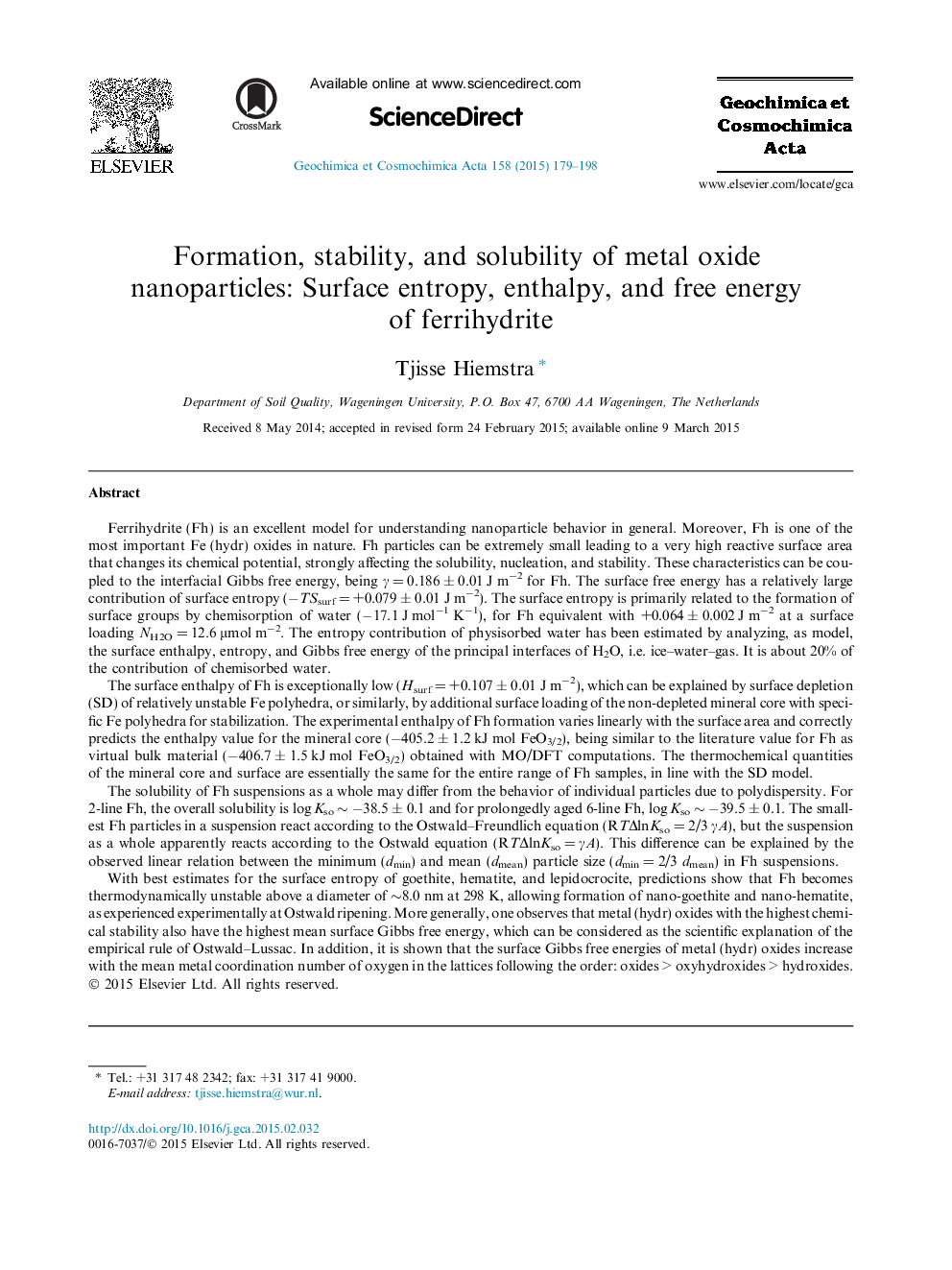| کد مقاله | کد نشریه | سال انتشار | مقاله انگلیسی | نسخه تمام متن |
|---|---|---|---|---|
| 4701930 | 1637999 | 2015 | 20 صفحه PDF | دانلود رایگان |
Ferrihydrite (Fh) is an excellent model for understanding nanoparticle behavior in general. Moreover, Fh is one of the most important Fe (hydr) oxides in nature. Fh particles can be extremely small leading to a very high reactive surface area that changes its chemical potential, strongly affecting the solubility, nucleation, and stability. These characteristics can be coupled to the interfacial Gibbs free energy, being γ = 0.186 ± 0.01 J m−2 for Fh. The surface free energy has a relatively large contribution of surface entropy (−TSsurf = +0.079 ± 0.01 J m−2). The surface entropy is primarily related to the formation of surface groups by chemisorption of water (−17.1 J mol−1 K−1), for Fh equivalent with +0.064 ± 0.002 J m−2 at a surface loading NH2O = 12.6 μmol m−2. The entropy contribution of physisorbed water has been estimated by analyzing, as model, the surface enthalpy, entropy, and Gibbs free energy of the principal interfaces of H2O, i.e. ice–water–gas. It is about 20% of the contribution of chemisorbed water.The surface enthalpy of Fh is exceptionally low (Hsurf = +0.107 ± 0.01 J m−2), which can be explained by surface depletion (SD) of relatively unstable Fe polyhedra, or similarly, by additional surface loading of the non-depleted mineral core with specific Fe polyhedra for stabilization. The experimental enthalpy of Fh formation varies linearly with the surface area and correctly predicts the enthalpy value for the mineral core (−405.2 ± 1.2 kJ mol FeO3/2), being similar to the literature value for Fh as virtual bulk material (−406.7 ± 1.5 kJ mol FeO3/2) obtained with MO/DFT computations. The thermochemical quantities of the mineral core and surface are essentially the same for the entire range of Fh samples, in line with the SD model.The solubility of Fh suspensions as a whole may differ from the behavior of individual particles due to polydispersity. For 2-line Fh, the overall solubility is log Kso ∼ −38.5 ± 0.1 and for prolongedly aged 6-line Fh, log Kso ∼ −39.5 ± 0.1. The smallest Fh particles in a suspension react according to the Ostwald–Freundlich equation (RTΔlnKso = 2/3 γA), but the suspension as a whole apparently reacts according to the Ostwald equation (RTΔlnKso = γA). This difference can be explained by the observed linear relation between the minimum (dmin) and mean (dmean) particle size (dmin = 2/3 dmean) in Fh suspensions.With best estimates for the surface entropy of goethite, hematite, and lepidocrocite, predictions show that Fh becomes thermodynamically unstable above a diameter of ∼8.0 nm at 298 K, allowing formation of nano-goethite and nano-hematite, as experienced experimentally at Ostwald ripening. More generally, one observes that metal (hydr) oxides with the highest chemical stability also have the highest mean surface Gibbs free energy, which can be considered as the scientific explanation of the empirical rule of Ostwald–Lussac. In addition, it is shown that the surface Gibbs free energies of metal (hydr) oxides increase with the mean metal coordination number of oxygen in the lattices following the order: oxides > oxyhydroxides > hydroxides.
Journal: Geochimica et Cosmochimica Acta - Volume 158, 1 June 2015, Pages 179–198
